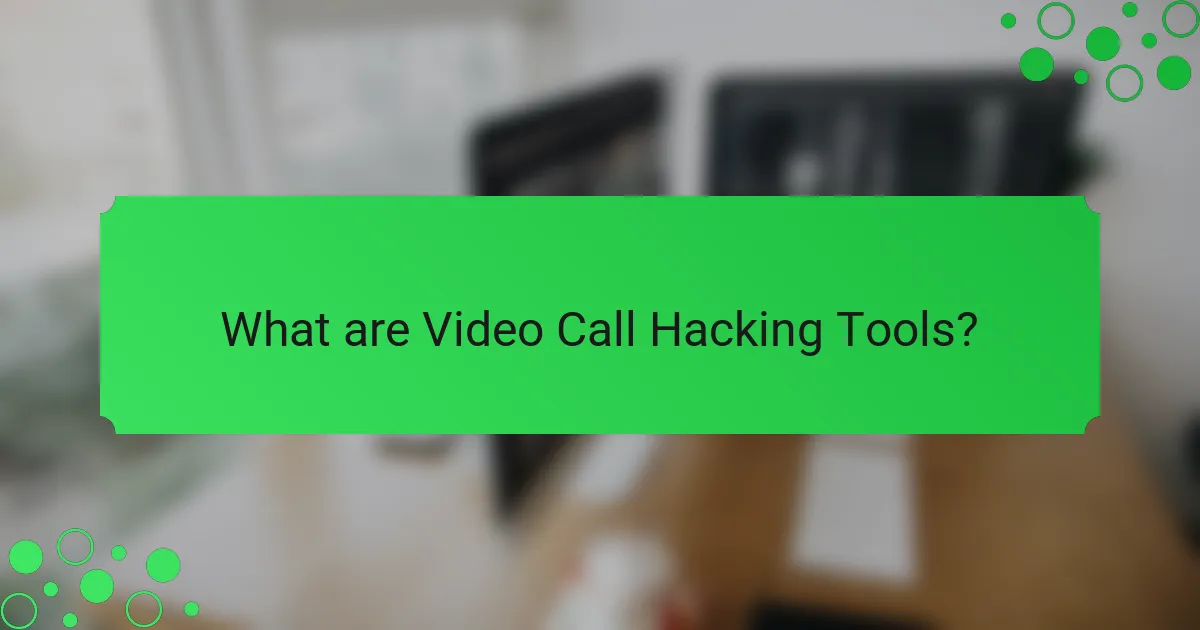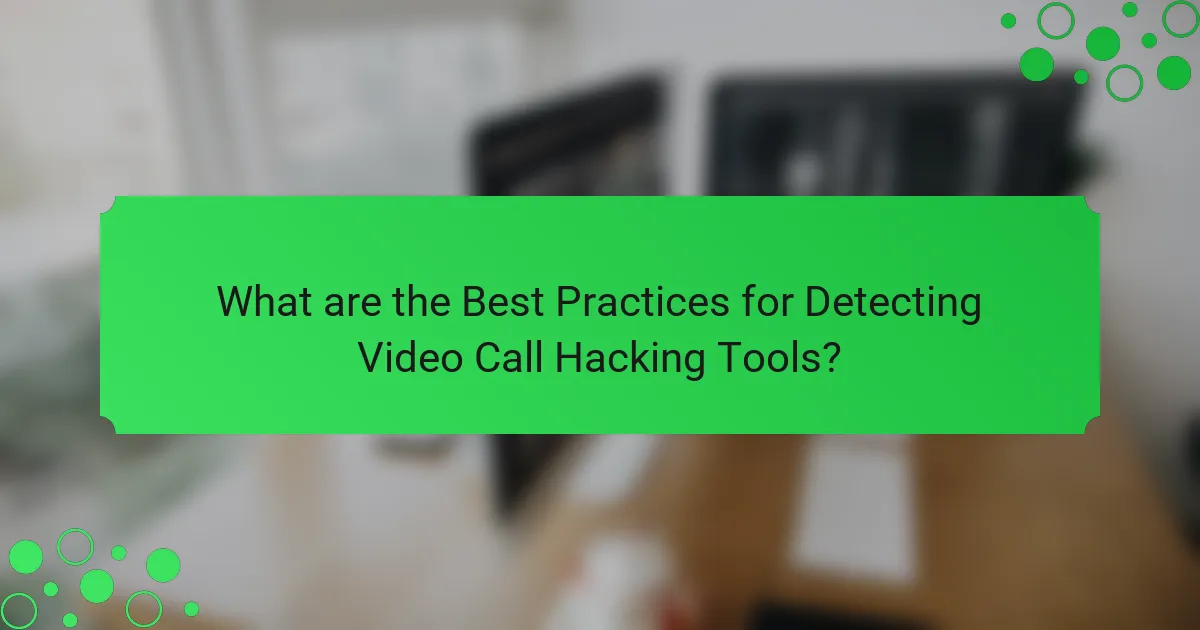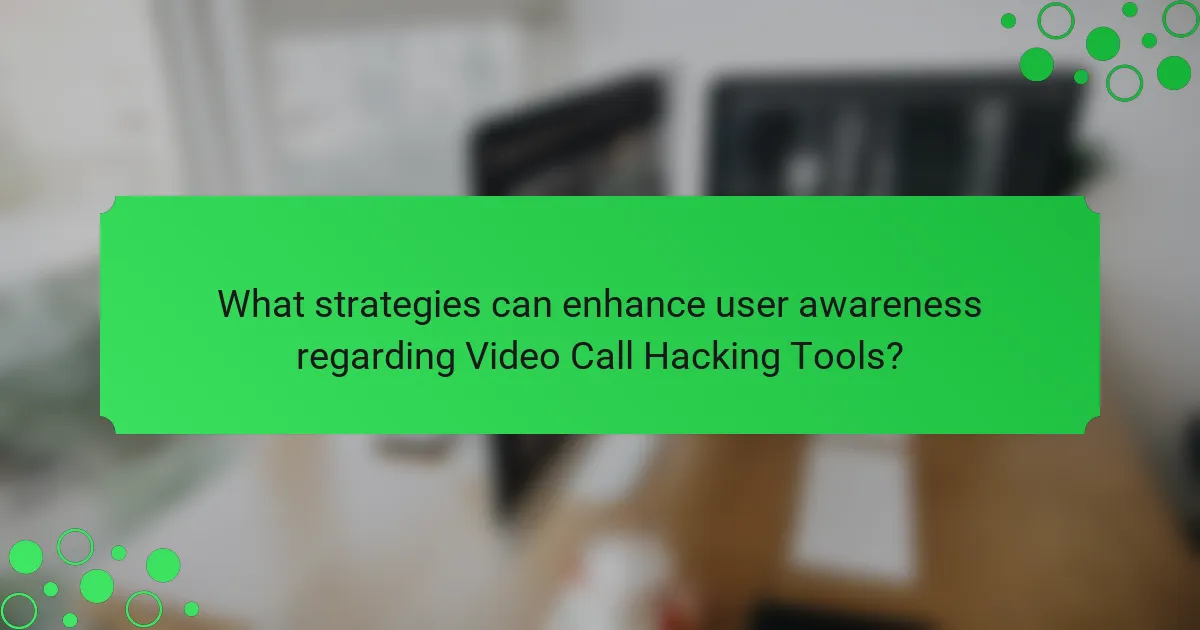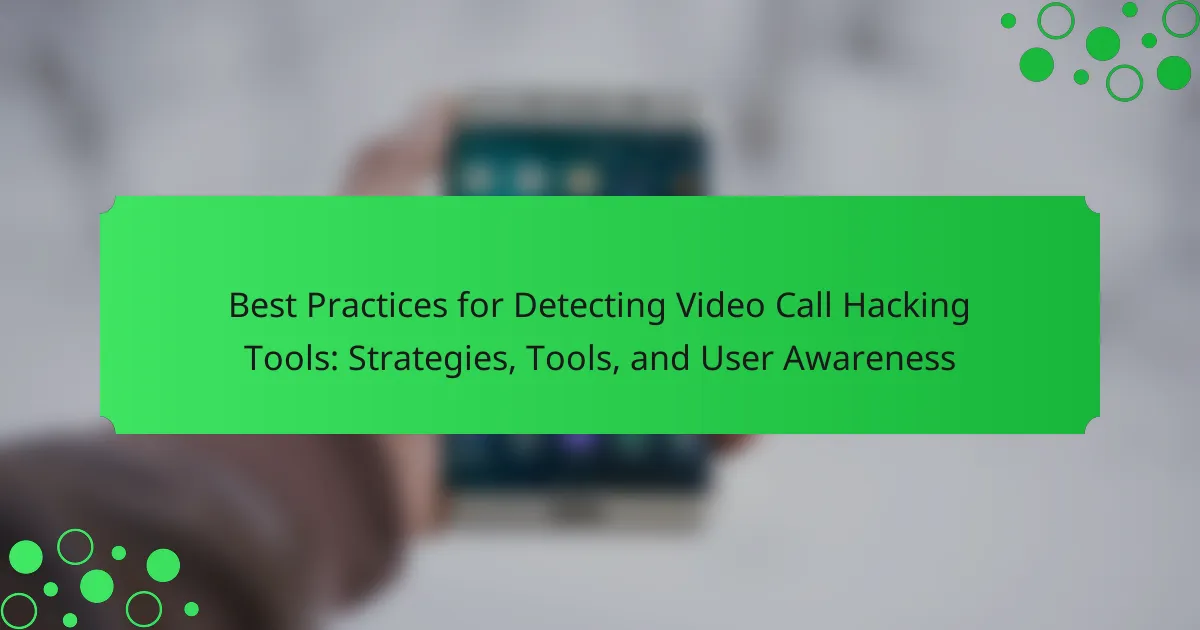Video call hacking tools are software applications that exploit vulnerabilities in video conferencing platforms, allowing unauthorized access to calls and communications. This article outlines best practices for detecting such hacking tools, emphasizing the importance of user awareness and cybersecurity measures. Key strategies include regularly updating software, utilizing endpoint security solutions, monitoring network traffic, and implementing strong password policies. Additionally, the article highlights the significance of educating users through training sessions, informative materials, and simulated phishing attacks to enhance overall security against potential threats.

What are Video Call Hacking Tools?
Video call hacking tools are software or applications designed to exploit vulnerabilities in video conferencing platforms. These tools can enable unauthorized access to video calls, allowing hackers to eavesdrop or disrupt communications. Common examples include malware that targets video conferencing software or phishing tools that trick users into revealing login credentials. According to a report by Cybersecurity Ventures, cybercrime is projected to cost the world $10.5 trillion annually by 2025, highlighting the significance of safeguarding video calls.
How do Video Call Hacking Tools operate?
Video call hacking tools operate by exploiting vulnerabilities in video conferencing software. These tools can intercept video and audio streams during a call. They may utilize malware to gain unauthorized access to devices. Some tools exploit weak passwords or lack of encryption in the software. Phishing attacks can also trick users into revealing sensitive information. Once access is gained, hackers can record conversations or capture images. Evidence shows that many popular video conferencing platforms have had security breaches. Regular updates and strong passwords can mitigate these risks.
What techniques do hackers use to infiltrate video calls?
Hackers use various techniques to infiltrate video calls. Common methods include phishing attacks to gain access to login credentials. They may also exploit vulnerabilities in video conferencing software. Malware can be installed on devices to capture video feeds. Additionally, hackers use social engineering to trick users into revealing sensitive information. Another technique involves intercepting network traffic to access video streams. These methods highlight the importance of secure passwords and updated software to prevent unauthorized access.
What types of vulnerabilities do these tools exploit?
Video call hacking tools exploit various vulnerabilities in software and hardware. Common vulnerabilities include weak encryption protocols. Many video conferencing applications use outdated or insufficient encryption, making them susceptible to interception. Another vulnerability is poor authentication mechanisms. Weak passwords and lack of two-factor authentication allow unauthorized access. Additionally, tools exploit software bugs and security flaws. These can be found in the video call software itself, leading to unauthorized control. Network vulnerabilities are also targeted. Insecure Wi-Fi networks can be easily compromised, allowing attackers to intercept calls. Lastly, social engineering tactics are often employed. Users may be tricked into revealing sensitive information, further exposing vulnerabilities.
Why is detecting Video Call Hacking Tools important?
Detecting video call hacking tools is important to safeguard privacy and secure sensitive information. Video calls often contain confidential discussions and personal data. If hackers gain access, they can exploit this information for malicious purposes. According to a report by Cybersecurity Ventures, video conferencing platforms have seen a 500% increase in security threats. Identifying hacking tools helps organizations implement necessary security measures. This proactive approach reduces the risk of data breaches and maintains user trust. Detecting such tools also encourages users to adopt safer practices during video calls.
How can video call hacking affect personal and business communications?
Video call hacking can severely compromise both personal and business communications. It can lead to unauthorized access to sensitive information shared during calls. Hackers may capture confidential discussions, impacting trust and privacy. For businesses, this can result in financial losses and reputational damage. A study by Cybersecurity Ventures estimates that cybercrime will cost the world $10.5 trillion annually by 2025, highlighting the financial risks involved. Additionally, personal relationships may suffer due to breaches of privacy and trust. Overall, the implications of video call hacking are significant and far-reaching.
What are the potential consequences of undetected hacking?
Undetected hacking can lead to severe consequences for individuals and organizations. Data breaches may occur, resulting in unauthorized access to sensitive information. This can compromise personal data, financial records, and proprietary business information. Financial losses can arise from fraud, theft, or ransomware attacks. Reputational damage often follows, eroding trust among customers and stakeholders. Legal repercussions may ensue, including fines and litigation costs. Operational disruptions can occur, hindering business continuity and productivity. According to a report by IBM, the average cost of a data breach in 2023 was $4.45 million, highlighting the financial impact of undetected hacking.

What are the Best Practices for Detecting Video Call Hacking Tools?
To detect video call hacking tools, use a combination of software solutions and user awareness practices. Regularly update your video conferencing software to patch vulnerabilities. Employ endpoint security solutions that can identify unusual behavior in applications. Monitor network traffic for anomalies that may indicate unauthorized access. Use strong, unique passwords and enable two-factor authentication for video call accounts. Educate users on recognizing phishing attempts and suspicious links. Regularly audit device permissions and access logs to identify potential breaches. These practices enhance security and reduce the risk of hacking incidents.
How can users recognize signs of hacking during video calls?
Users can recognize signs of hacking during video calls by observing unusual behavior and technical issues. Common indicators include unexpected disconnections or poor video and audio quality. If participants experience significant lag or freezing, it may suggest interference. Additionally, uninvited guests appearing on the call can indicate unauthorized access. Users should be cautious if the host’s controls seem altered or if screen sharing occurs without notice. Monitoring for odd background noises or echoes can also signal a breach. Lastly, if the call suddenly ends without explanation, it may warrant further investigation into potential hacking.
What specific indicators should users look for?
Users should look for unusual behavior during video calls as specific indicators of hacking tools. Signs include unexpected disconnections or poor video quality. Users should also be alert to unfamiliar participants joining the call. Unusual background noises or echoes may indicate unauthorized access. Sudden changes in camera or microphone settings can signal tampering. Additionally, users should monitor for strange or delayed responses from participants. Regular software updates and security alerts can help identify potential threats. These indicators are essential in maintaining the security of video conferencing platforms.
How can unusual behavior signal a potential hack?
Unusual behavior can signal a potential hack by indicating unauthorized access or manipulation of a system. This behavior may include unexpected software installations or changes in settings. Users might notice strange pop-up messages or unfamiliar applications running. Additionally, abnormal network activity, such as increased data usage, can be a red flag. Sudden changes in user account behavior, like password resets or login attempts from unknown devices, also suggest a compromise. According to the Cybersecurity & Infrastructure Security Agency (CISA), monitoring for these signs is crucial in identifying potential intrusions.
What tools are available for detecting Video Call Hacking Tools?
Network monitoring tools can detect video call hacking tools. These tools analyze data traffic for unusual patterns. Examples include Wireshark and SolarWinds. Wireshark captures and inspects data packets in real-time. SolarWinds provides comprehensive network performance monitoring. Antivirus software can also help identify malicious software. Programs like Norton and McAfee scan for known threats. Additionally, endpoint detection and response (EDR) solutions monitor endpoint activities. Tools such as CrowdStrike and SentinelOne offer advanced threat detection. Regular software updates are crucial for maintaining security. Keeping systems updated reduces vulnerabilities that hackers exploit.
What software solutions can help monitor video call security?
Software solutions that can help monitor video call security include tools like Zoom’s Security Dashboard, Microsoft Teams’ Compliance Center, and Cisco Webex’s Security Monitoring. These platforms provide features such as end-to-end encryption and user access controls. They also offer real-time monitoring of meetings for unauthorized access. For example, Zoom’s Security Dashboard allows administrators to track meeting participants and report suspicious activities. Microsoft Teams provides compliance tools that help organizations meet regulatory requirements. Cisco Webex includes alerts for unusual activity during calls. Each of these solutions enhances the security of video calls by providing oversight and control mechanisms.
How do these tools enhance user awareness of potential threats?
These tools enhance user awareness of potential threats by providing real-time alerts and notifications. They analyze video call data for suspicious activity. Users receive immediate feedback on any detected anomalies. This proactive approach helps users recognize threats early. Additionally, educational resources accompany these tools. They offer insights into common hacking tactics. Users learn to identify red flags during video calls. Research indicates that informed users are less likely to fall victim to attacks. Therefore, these tools significantly improve overall user vigilance regarding security threats.

What strategies can enhance user awareness regarding Video Call Hacking Tools?
Educating users about video call hacking tools can be enhanced through various strategies. First, providing regular training sessions on cybersecurity is essential. These sessions should cover the latest threats and how to recognize suspicious activity. Second, creating informative materials, such as brochures or infographics, can help visualize risks and protective measures. Third, implementing simulated phishing attacks can raise awareness by demonstrating potential vulnerabilities. Fourth, encouraging the use of strong, unique passwords for video call applications is crucial. Additionally, promoting the importance of software updates can protect against known vulnerabilities. Lastly, fostering a culture of open communication about security concerns can empower users to report suspicious activity.
How can users educate themselves about video call security?
Users can educate themselves about video call security by researching best practices and utilizing available resources. They should read articles, guides, and studies focusing on video conferencing security. Websites like the Cybersecurity & Infrastructure Security Agency (CISA) provide valuable insights. Users can also attend webinars or online courses on cybersecurity. Engaging with community forums can enhance understanding through shared experiences. Regularly updating software and applications is crucial for security. Familiarizing themselves with common threats, such as phishing and unauthorized access, helps users stay vigilant. Following these steps ensures a well-rounded approach to video call security education.
What resources are available for learning about video call hacking risks?
Resources for learning about video call hacking risks include cybersecurity websites, online courses, and academic research papers. Websites like Cybersecurity & Infrastructure Security Agency (CISA) provide guidelines on securing video calls. Online platforms such as Coursera and Udemy offer courses focused on cybersecurity and video conferencing security. Research papers, like “Cybersecurity Risks in Video Conferencing” by Smith et al., provide in-depth analysis and statistics on vulnerabilities. Additionally, industry blogs and forums discuss recent threats and preventive measures. These resources equip users with knowledge to mitigate risks associated with video calls.
How can training programs improve user vigilance against hacking?
Training programs can improve user vigilance against hacking by educating users about potential threats and safe online practices. Users learn to recognize phishing attempts and suspicious activities. This knowledge empowers them to take proactive measures. Regular training reinforces awareness of new hacking techniques. Research shows that organizations with ongoing security training see a 70% reduction in security incidents. Additionally, simulations during training help users practice responses to hacking scenarios. These experiences build confidence and preparedness. Overall, training programs create a culture of security mindfulness among users.
What tips can users implement to protect against video call hacking?
Use strong, unique passwords for video call accounts. Enable two-factor authentication for added security. Regularly update video conferencing software to patch vulnerabilities. Be cautious of suspicious links and attachments in messages. Use a virtual private network (VPN) for secure connections. Lock meetings with passwords to restrict access. Disable screen sharing for unknown participants. Monitor participant lists during calls for unfamiliar attendees.
How can users secure their devices before video calls?
Users can secure their devices before video calls by implementing several key practices. First, ensure that the operating system and all applications are updated regularly. This helps close security vulnerabilities that could be exploited. Second, utilize strong, unique passwords for all accounts related to video calling. Password managers can assist in generating and storing these securely. Third, enable two-factor authentication where available to add an extra layer of security. Fourth, use a reputable antivirus program to detect and remove any malware that may compromise device security. Fifth, avoid joining video calls over public Wi-Fi networks, as these can be insecure. Finally, review and adjust privacy settings on video call platforms to limit data sharing. These steps collectively enhance device security and reduce the risk of unauthorized access during video calls.
What best practices should users follow during video calls to ensure safety?
Users should follow several best practices during video calls to ensure safety. First, they should use secure and updated software for video conferencing. This helps protect against vulnerabilities. Users must also enable password protection for meetings. This prevents unauthorized access.
Additionally, users should avoid sharing meeting links publicly. This reduces the risk of unwanted participants joining. Users should also be cautious about sharing personal information during calls. This minimizes exposure to potential threats.
Furthermore, they should utilize virtual backgrounds or blur features. This protects their privacy by concealing their surroundings. Finally, users must remain vigilant for suspicious behavior from other participants. Reporting any anomalies can help maintain a secure environment.
Video call hacking tools are software designed to exploit vulnerabilities in video conferencing platforms, allowing unauthorized access to communications. This article outlines best practices for detecting these tools, focusing on strategies, software solutions, and user awareness to enhance security. Key topics include the operation of hacking tools, techniques used by hackers, common vulnerabilities, and the importance of recognizing signs of hacking during video calls. Additionally, it emphasizes the need for user education and proactive measures to safeguard personal and business communications from potential breaches.
